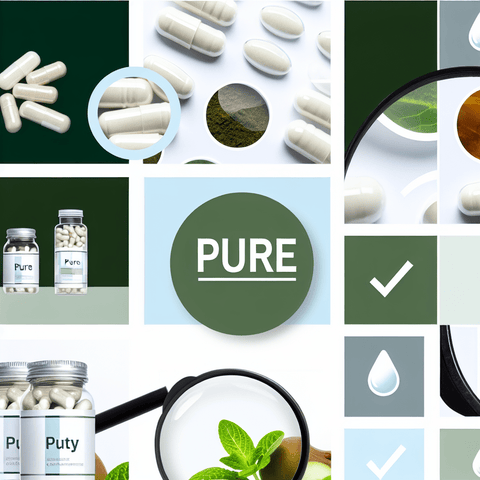Introduction
Nutritional supplements have become a staple in many health-conscious individuals' routines, offering a convenient way to ensure that they are meeting their daily nutrient requirements. However, not all supplements are created equal. Many products on the market contain fillers and additives that may affect their quality and safety. This comprehensive guide will walk you through understanding these components, how to identify them, and ensuring that you are consuming the best supplements for your health.
Understanding Fillers in Nutritional Supplements
Fillers are inactive ingredients added to supplements primarily to bulk up the product, making it easier to handle and manufacture. While fillers might seem harmless, they can sometimes cause adverse reactions, especially in individuals with allergies or sensitivities. Common fillers include lactose, gluten, and magnesium stearate. It's essential to scrutinize the ingredient list on supplement labels to avoid unwanted fillers. For instance, lactose might be problematic for those who are lactose intolerant, and gluten can trigger reactions in people with celiac disease or gluten sensitivity.
To ensure you’re selecting a supplement free from unnecessary fillers, opt for products that list only the active ingredients and a minimal number of inactive ones. Brands that prioritize transparency will often highlight the purity of their products, making it easier to choose high-quality options. For example, if you're looking to boost your vitamin D intake, consider checking [this collection](https://www.topvitamine.com/collections/vitamin-d-benefits-sources-safety) that focuses on pure and safe vitamin D options.
Spotting Additives in Your Supplements
Additives are ingredients used to enhance the taste, appearance, or shelf life of supplements. While they serve functional purposes, some additives can be harmful or unnecessary. Common additives include artificial colors, flavors, and preservatives. Artificial colors, such as those labeled as FD&C or D&C, are often derived from petroleum and may pose health risks. Similarly, artificial flavors can mask the natural taste of the product, leading to misleading perceptions of the supplement's quality.
Preservatives, such as parabens and sulfites, are used to extend the shelf life of supplements but can potentially cause allergic reactions in sensitive individuals. To ensure you are consuming supplements without harmful additives, look for products that use natural alternatives. For instance, natural vitamin C supplements often use ascorbic acid derived from fruits, providing a safer alternative to synthetic versions. Explore [this vitamin C collection](https://www.topvitamine.com/collections/vitamin-c-benefits-immunity-antioxidant-energy) for high-quality, additive-free options.
The Role of Magnesium Stearate in Supplements
Magnesium stearate is one of the most common additives found in supplements, used as a flow agent to prevent the ingredients from sticking to the manufacturing equipment. While generally considered safe, its presence has sparked debate. Some argue that it may inhibit nutrient absorption, while others refute these claims, citing a lack of substantial evidence.
For individuals seeking to avoid magnesium stearate, it’s crucial to read supplement labels carefully. If you prefer supplements without this additive, you might explore formulations that use alternative flow agents or those that are explicitly marketed as free from magnesium stearate. For those interested in bone and muscle support without unwanted additives, the [magnesium collection](https://www.topvitamine.com/collections/magnesium-benefits-energy-muscle-bone-support) offers high-quality options.
Identifying Synthetic Vitamins in Supplements
Synthetic vitamins are artificially manufactured ingredients designed to mimic the structure of natural vitamins. While they are effective in providing the necessary nutrients, some individuals prefer natural sources due to concerns about absorption and efficacy. Synthetic vitamins often appear on labels with their chemical names, such as ascorbic acid for vitamin C or retinyl palmitate for vitamin A.
To identify synthetic vitamins, look for specific labeling that indicates the source of the vitamin. Products that highlight "natural" or "whole food-based" often contain nutrients derived from food sources rather than synthesized in a lab. Additionally, these products may offer better bioavailability, meaning your body can absorb and utilize the nutrients more efficiently. If you're considering an omega-3 supplement, the [DHA/EPA omega-3 collection](https://www.topvitamine.com/collections/dha-epa-omega-3-supplements) includes options that prioritize natural sources.
Choosing High-Quality Supplements
When it comes to choosing supplements, quality is paramount. High-quality supplements are those that contain pure, potent ingredients without unnecessary fillers or additives. To identify such products, consider the following factors: third-party testing, certifications, and brand reputation. Third-party testing ensures that the product contains what it claims without contaminants. Certifications from recognized bodies, such as NSF International or USP, indicate that the product meets high standards of quality and purity.
Additionally, research the brand's reputation and transparency regarding their sourcing and manufacturing processes. Brands that openly share their testing results and ingredient sources are typically more trustworthy. For bone and blood health, [vitamin K supplements](https://www.topvitamine.com/collections/vitamin-k-benefits-bone-blood-health) offer products that meet stringent quality criteria.
Conclusion
Understanding how to identify fillers and additives in nutritional supplements is crucial for maintaining a safe and effective health regimen. By carefully examining ingredient labels and opting for products with minimal inactive ingredients, you can ensure that you are consuming high-quality supplements. Remember, the best supplements are those that provide the necessary nutrients without unnecessary additives, enhancing both your health and peace of mind.
Q&A Section
Q: What are fillers in supplements, and why are they used?
A: Fillers are inactive ingredients added to supplements to bulk up the product, making it easier to handle and manufacture. They are used for stability and to ensure uniformity in production.
Q: Are additives in supplements harmful?
A: While not all additives are harmful, some can cause adverse reactions, especially in sensitive individuals. It’s important to check the ingredient list for artificial colors, flavors, and preservatives.
Q: How can I tell if a supplement contains synthetic vitamins?
A: Synthetic vitamins are often listed by their chemical names. Look for supplements labeled as "natural" or "whole food-based" to ensure they contain nutrients from natural sources.
Q: What should I look for in a high-quality supplement?
A: Look for third-party testing, certifications, minimal inactive ingredients, and transparency from the brand about their sourcing and manufacturing processes.
Important Keywords
Fillers, Additives, Nutritional Supplements, Quality, Safety, Magnesium Stearate, Synthetic Vitamins, High-Quality Supplements, Third-Party Testing, Certification, Natural Sources, Bioavailability.



